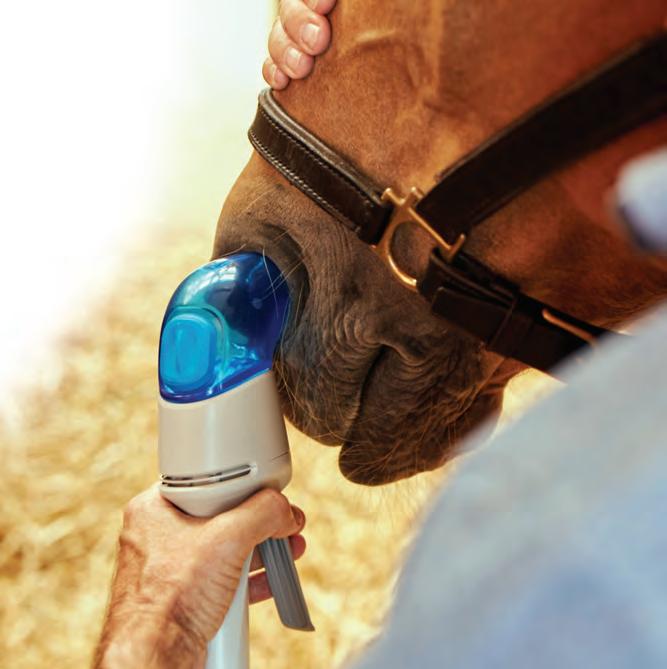
3 minute read
When a down horse was brought to the WCVM Veterinary Medical Centre last fall, the large animal clinical team was ready to help
New therapy helps horses breathe better
By Myrna Macdonald
Canadians have access to the first licensed and approved inhalation therapy specifically developed to help horses with severe equine asthma without causing unwanted side effects. Developed by Boehringer Ingelheim Animal Health (BI), the Aservo® EquiHaler® is an inhalation therapy available through veterinarians. It’s used to treat severe equine asthma, formerly known as recurrent airway obstruction (RAO) or heaves. Like humans, environmental triggers such as inhalable organic and inorganic dust, mould, bacteria and pollen cause asthma in horses. Feeding dry hay — especially low-quality feed — is the most common source of these particles. Horses with severe asthma suffer from chronic cough, nasal discharge, excessive effort when breathing, poor recovery after exercise or exercise intolerance, and weight loss. The product uses ciclesonide, a corticosteroid, with a Soft Mist InhalerTM — a unique inhalant delivery system that BI initially developed for use in human respiratory therapies. “It ticks all of the boxes: it’s the only licensed, inhaled product available for equine asthma on the market, and it’s very efficacious with a simple 10-day protocol,” says Dr. Doug Myers, BI’s western Canadian technical services veterinarian. Once prescribed, an owner inserts the device into the horse’s left nostril and delivers a series of “puffs” — eight puffs twice a day for five days, followed by 12 puffs once a day for another five days. Defined as a “prodrug,” ciclesonide is a biologically inactive compound. Once inhaled, it metabolizes and transforms into a much more potent corticosteroid that helps treat inflammation directly in the lungs. “The Soft Mist InhalerTM technology delivers the drug through the horse’s nostril so it avoids the issue of [the drug] being accidentally swallowed. It’s easy to inhale as the mist goes in at a very low velocity, naturally following the inhaled air, and the particle size is very small — less than five microns — so the drug gets directly into the horse’s lungs,” says Myers. He adds that after some initial training, most horses in clinical trials accepted the inhaler without issues. The device is meant for a 10-day treatment period, and since it’s licensed as a pharmaceutical product, it can’t be reused. The new therapy became the first product to receive dual approval by the U.S. Food and Drug Administration and Canada’s Veterinary Drug Directorate in April 2020. While the therapy was available in Europe and the U.S. last year, it was just launched in Canada in January 2021. One Canadian veterinarian who has been waiting to use the product is Dr. Julia Montgomery, a large animal internal medicine specialist and researcher at the Western College of Veterinary Medicine (WCVM). She reviewed a prototype in 2019 when she and other equine asthma specialists attended a BI advisory meeting in Québec. Montgomery is excited about the new therapy for two reasons. First, it doesn’t cause systemic cortisol suppression, which can lead to immunosuppression or even laminitis — a side effect of some corticosteroids. This is good news for horses that already have a higher risk of developing laminitis because of pre-existing conditions. “The second reason is that they’ve (BI) done really good field trials with a large number of horses, both in Europe and North America,” says Montgomery. “They’ve done a good job on efficacy and safety.” Over 600 horses participated in clinical trials that included healthy horses and horses with severe asthma. The trials clearly demonstrated that the therapy is effective in reducing clinical signs of the disease. While the inhalant therapy is effective, Myers and Montgomery stress that environmental management — decreasing dust and allergens — is the first step in treating equine asthma. “Asthma is a chronic disease, so one of the really important messages to get across to horse owners is that none of this will work if you don’t also change the horse’s environment,” says Montgomery. “Essentially these steroids are to treat flare-ups of asthma — it’s to get them past the acute phase of the disease, and some may need another treatment.” Visit bicanadaequine.ca for more information. the inhalant device is inserted into the horse’s left nostril and delivers a series of “puffs.”






